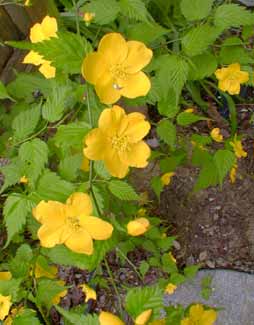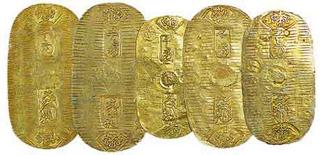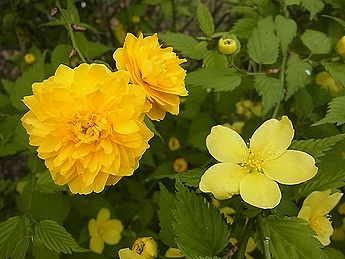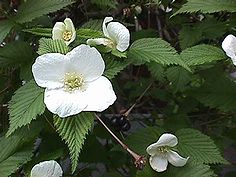Tamagawa, see below
:::::::::::::::::::::::::::::::::::::::::::::::::::::::::::::::::::::::::::::::::::::::::::::::::::::
Yellow Mountain Rose (yamabuki)
***** Location: Japan
***** Season: Late Spring
***** Category: Plant
*****************************
Explanation

http://www.paghat.com/kerria.html
Kerria japonica . Yamabuki 山吹
litterally means "mountain breath". These bright yellow flowering bushes grow wild all over Japan, especially favoring riversides and gorges. Other translations are "Mountain rose, wild rose, Easter rose".
white mountain rose : shiro-yamabuki 白山吹
double-flowering mountain rose :
yae-yamabuki 八重山吹
dark yellow mountain rose : ko-yamabuki 濃山吹
mountain rose with leaves : ha yamabuki 葉山吹
The flowers have five petals, while the doublel-flowering looks like a ponpon with many petals.
They paint whole mountain ranges in bright yellow in late spring. Since olden times, these flowers have been a part of Japanese poetry, especially the Manyo'shu and the Tale of Genji. See later.
The bright yellow has been used to describe the yellow color of gold, especially the gold plates of Japanese money during the Edo period. "Yamabuki-iro" is the color of gold and bribes.

http://www.pierre-marteau.com/currency/coins/japanese.html
Below I quote a link about this kind of Japanese Money.
Gabi Greve
xxxxxxxxxxxxxxxxxxxxxxxxxxxxx
Double-flowering yellow mountain rose

White mountain rose

Look at more pictures here:
http://www.hana300.com/yaeyam.html
:::::::::::::::::::::::::::::::::::::::::::::::::::::::::::::::::::::::::::::::::::::::::::::::::::::
kigo for all winter
kare yamabuki, kareyamabuki 枯山吹 (かれやまぶき)
withered yellow rose bush
:::::::::::::::::::::::::::::::::::::::::::::::::::::::::::::::::::::::::::::::::::::::::::::::::::::
Yamabuki (Kerria japonica)
By LINDA INOKI
Murasaki had prepared the floral offerings.
She chose eight of her prettiest little girls to deliver them,
dressing four as birds and four as butterflies.
The birds brought cherry blossoms in silver vases,
the butterflies yamabuki in gold.
From "The Tale of Genji" by Murasaki Shikibu,
translated by Edward G. Seidensticker (Penguin Books)
The simple, pure-yellow flowers of the yamabuki are borne in arching sprays with tender, bright-green leaves, and can still be found growing wild in the mountains. In literature, its Japanese name is sometimes translated as "mountain rose" or "yellow rose," although the original implies a mountain breeze or spray.
William Kerr, the first plant hunter to live in China, introduced the shrub to the West in the early 1800s, where the double variety was affectionately called "bachelor's buttons," because of its showy spring display.
© The Japan Times: Apr. 12, 2001
http://www.japantimes.co.jp/cgi-bin/getarticle.pl5?fl20010412li.htm
xxxxxxxxxxxxxxxxxxxxxxxxxxxxx
More Links about this plant:
http://www.hort.uconn.edu/plants/k/kerjap/kerjap1.html
http://home.hiwaay.net/~oliver/kerria.html
http://www.manntaylor.com/plantweek51.html
..................................................................

The shrub is especially associated with the Ide Tamagawa 井出 玉川, a river near Kyoto, which was well-famed for Yamabuki that flourish along its banks. Flower-viewing excursions were arranged among courtiers & courtesans specifically to observe Yamabuki in spring along the Ide Tamagawa. These excursions could be very expensive, & men who idled away their time in pleasure district activities were said to be "scattering gold coins as the Yamabuki scatters golden petals."
Hiroshige in 1830 illustrated the Kerria Rose overshadowing two frogs, in one of a famous series of plant portraits accompanied by the opening lines of poems. The jist of the poem that accompanies the famous picture can be paraphrased: "Frogs are calling in the spring rain, when the Yamabuki fails to shelter them.
"Why does the Kerria fail as a rain-shelter for frogs? Perhaps literally because the frogs are active so early in the spring that the Kerria hasn't yet regained all of its sheltering leaves. But the poem alludes to a mino which is a raincoat made of grass, punning this with the same word that means "seed" or "fruit." The Yamabuki is proverbially believed to be sterile, thus cannot provide the frog with a raincoat (mino) because it has no fruits (mino).
The pun is no mere jest, however, for it embodies a Buddhist sense of mono-no-aware, the sadness of things. So the poem's sentment could be rephrased: "The Yamabuki has flowers like the brocade robes of the wealthy, yet it is so poor it cannot afford even a grass raincoat."
In another story about Oota Dookan and a fair maiden, we read this song:
The Yamabuki enriches our house with flowers,
yet there is sadness here,
for these riches are an illusion,
and our flower has no mino (fruit)
Read a lot more about the Mountain Rose here:
http://www.paghat.com/kerria.html
. Oota Dookan 太田道灌 Ota Dokan .
(1432-1486)
.. .. .. ..
Here is another short quote concerning the above print from Hiroshige,
from a long essay about Haiku by Haruo Shirane
... the poetic essence of the kawazu, or frog, a seasonal word for spring, was song, usually calling for its mate, standing beneath the yamabuki (kerria), the bright yellow mountain rose, found on the banks of a river or stream, with its petals reflected in the clear water.
http://www.columbia.edu/cu/ccba/cear/issues/fall99/text-only/shirane.htm
Ide no Tamagawa 井手の玉川 in Kyoto

quote
Ide Tamagawa Screens by Kano Tanshin Morimasa
The Ide Tamagawa scenery has long been extolled in waka poetry, and in particular the waka poems of the late Heian period poet Fujiwara Shunzei were often the basis for such paintings.
... This painting extracts only the bird and flower motifs from the Ide Tamagawa imagery that typically also included figural forms, and further recomposes the image to include grasses and flowers unrelated to the original poem.
source : cool_japan/culture
こまとめてなを水かはんやまぶきの
花のつゆそふ井での玉河
koma tomete nao mizu kahan yamabuki no
hana no tsuyu soo Ide no Tamagawa

Pulling up my horse
after having passed the banks
I see the petals
of Yamabuki roses
in Ide’s Tamagawa
Fujiwara no Shunzei 藤原俊成 (1114 - 1204)
source : mu_tamagawa.html
. The six Tamagawa (Jewel Rivers 玉川) .
*****************************
Worldwide use
*****************************
Things found on the way
Read some detailed information about Japanese Money.
http://www.pierre-marteau.com/currency/coins/japanese.html
My story about the Color YELLOW in traditional Japanese kimono
and yellow Daruma.
- Yellow Daruma Dolls -l
*****************************
HAIKU

Picture and Hokku by Matsuo Basho
ほろほろと山吹散るか滝の音
horo horo to yamabuki chiru ka taki no oto
horohoro, horo-horo
Petals of the mountain rose
Fall now and then,
To the sound of the waterfall.
Tr. Blyth
the petals temble
on the yellow mountain rose -
roar of the rapids
- haiku.insouthsea.co.uk/
quote
yamabuki flowers
falling scatteringly;
sound of waterfall
Petals of yamabuki, a kind of bright-yellow globeflower, are falling as if they are allured by the sound of a waterfall. The image of yamabuki is actually transformed into the image of the sound of a waterfall. The charm of this haiku lies in the juxtaposition of the heavy sound and movement of falling water with the light sound and movement of falling yellow flowers.
source : TOSHIMI HORIUCHI , 2001
Written in 1688 貞享5年
Oi no Kobumi
At the waterfall of Nijikoo no Taki 西河の滝 Nijiko no Taki. This is upriver from Yoshinogawa 吉野川. Near the bottom of the fall is an abundance of the yellow mountain roses.
This hokku has the cut marker KA at the end of line 2.

source : odn.ne.jp/j-kingdom
petals of mountain roses
fall ever so gently -
sound of this waterfall
Tr. Gabi Greve
quote
Nijiko is an area of the Yoshino River known for powerful rapids. In the haibun “Petal
by Petal,” where Basho¯ refers to a waka by Ki no Tsurayuki:
At Yoshino River,
the mountain roses at the riverbank
in the blowing wind:
even the reflections in the depths
are scattered
(yoshino-gawa / kishi no yamabuki / fuku kaze ni
soko no kage sae /utsuroinikeri).
source : Barnhill - haikupedia.ru
MORE - hokku about waterfalls by
. Matsuo Basho 松尾芭蕉 - Archives of the WKD .
. Matsuo Basho in Yoshino 吉野山 .
.............................................................................
山吹や笠に挿すべき枝の形
yamabuki ya kasa ni sasu beki eda no nari
a mountain rose -
I should stick it in my hat
just like a branch
Tr. Barnhill
Written in 元禄4年, Basho age 44
At a dwelling in Akasaka, Edo 赤坂の庵.

A hat with a flowering branch or blossoms (hanagasa 花笠) is often used for festivals in Japan, and also in spring for cherry blossom viewing. Basho seems in a festive mood when he observes the yellow yamabuki.
MORE - hokku about the traveler's hat of
. Matsuo Basho 松尾芭蕉 - Archives of the WKD .
. kanzashi かんざし / 簪 hairpin .
:::::::::::::::::::::::::::::::::::::::::::::::::::::::::::::::::::::::::::::::::::::::::::::::::::::
. WKD : Kobayashi Issa 小林一茶 .
yamabuki ni te o kazashitaru itachi kana
in yellow roses
shading his eyes to gaze ..
a weasel
Issa
Tr. David Lanoue
yamabuki ya mazu o-saki e to tobu kawazu
yellow rose
please, you go first
frog jumping
Issa
Tr. David Lanoue
..........................................................................
Another haiku by Issa with a "yellow voice"
There is also an animal
ko-oo 黄鶯 "yellow uguisu" コウライウグイス
鶯や黄色な声で親をよぶ
uguisu ya kiiro na koe de oya o yobu
nightingale--
with a shrill voice
calling mother
Tr. David Lanoue
The young uguisu
Calls its parents
With a yellow voice.
Tr. Blyth
the Bush Warbler
with a yellow voice/call
calls for its parents
Japanese English: Language and Culture Contact
source : James Stanlaw
The youngest nightingale that can rejoice
calls to its parents in a yellow voice.
Issa must have been in deep meditation and he heard the nightingale rejoicing and calling to its parents in a yellow voice.
Issa is saying something about his silence. When you are in silence and a cuckoo from the bamboos starts singing, it deepens your silence.
source : shiromani
Continued here
. YELLOW and Haiku .
. Voices of animals in haiku .
:::::::::::::::::::::::::::::::::::::::::::::::::::::::::::::::::::::::::::::::::::::::::::::::::::::::::::::::::
山吹や 井出を流るる 鉋屑
yamabuki ya Ide o nagaruru kannakuzu
these yellow roses -
wood shavings are flowing down
the river Ide
Tr. Gabi Greve
The cut marker YA is at the end of line 1.
. Yosa Buson 与謝蕪村 in Edo .
*****************************
Related words
kigo for late spring
***** yamabukisoo 山吹草 (やまぶきそう) "Yamabuki plant"
kusa yamabuki 草山吹(くさやまぶき)
Chelidonium japonicus
:::::::::::::::::::::::::::::::::::::::::::::::::::::::::::::::::::::::::::::::::::::::::::::::::::::
kigo for late summer
***** kusanooo, kusa no oo isoo くさのおう "king of plants"
..... 白屈菜(くさのおう) 草の黄(くさのおう)"yellow plant"
tamushi soo 田虫草(たむしそう)
Chelidonium majus, bloodroot
© More in the WIKIPEDIA !
***** . PLANTS in all seasons . . . SAIJIKI
***** . Colors used in Haiku .
:::::::::::::::::::::::::::::::::::::::::::::::::::::::::::::::::::::::::::::::::::::::::::::::::::::::::::::::::::::::::::
[ . BACK to DARUMA MUSEUM TOP . ]
[ . BACK to WORLDKIGO . TOP . ]
:::::::::::::::::::::::::::::::::::::::::::::::::::::::::::::::::::::::::::::::::::::::::::::::::::::::::::::::::::::::::::








5 comments:
山吹や宇治の焙炉の匂ふ時
yamabuki ya Uji no hoiro no niou toki
mountain roses -
when tea ovens at Uji
are so fragrant
Matsuo Basho
Tr. Barnhill
MORE
about drinking rea with Basho!
山吹の露菜の花のかこち顔なるや
yamabuki no tsuyu na no hana no kakochigao naru ya
dew on the yellow roses
the rapeseed flowers make a face
of envy !
Tr. Gabi Greve
Written in 延宝9年, Basho age 38
The dew on yamabuki has been the subject of poetry since the Heian period. But nobody ever wrote about the dew on rapeseed flowers.
.
Matsuo Basho at Ide
山城へ井出の駕籠借る時雨哉
Yamashiro e Ide no kago karu shigure kana
to Yamashiro
I had to use a sedan chair from Ide
because of the winter sleet . . .
神垣に引きよせてあり濃山吹
kamigaki ni hikiyosete ari koyamabuki
to the fence of the Gods
they come leaning -
the dark yellow mountain roses
Nomura Hakugetsu 野村泊月(1882 - 1961)
MORE
about kamigaki fences
玉川八十八ケ所 -
Tamagawa Henro Pilgrims in Kanto
.
http://www.tesshow.jp/tamagawa88_index.html
.
Kobo Daishi Reijo 弘法大師霊場 Kobo Daishi Pilgrimages in Japan
.
Post a Comment